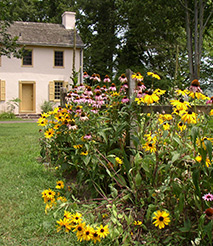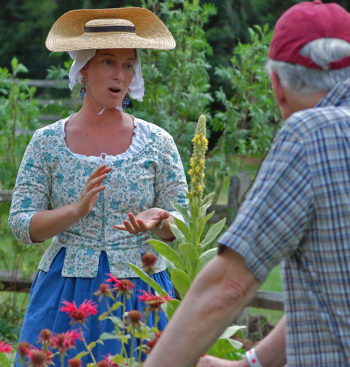By Anna Davis-Agostini, M.S.
 One of the missions of the Friends of Washington Crossing Park is to help modern-day visitors glimpse into the colonial era of the late 1700s. The Friends help to maintain and exhibit the houses in the Colonial Village section of the park, but the best way to fully incorporate the spirit of 1776 into that park area is with an equally historically accurate garden.
One of the missions of the Friends of Washington Crossing Park is to help modern-day visitors glimpse into the colonial era of the late 1700s. The Friends help to maintain and exhibit the houses in the Colonial Village section of the park, but the best way to fully incorporate the spirit of 1776 into that park area is with an equally historically accurate garden.
The petite and quaint curated garden maintained by Washington Crossing Historic Park has more than enough to capture the imagination of late 18th-century life. There would not have been a garden in its current location at the time when General Washington crossed the Delaware—the sprinkling of houses in the Colonial Village section of the park are actually the homes of the Taylorsville Village, dating to around the 1820s (with the exception of McConkey’s Ferry Inn, which was indeed here during Washington’s time).
Bearing this in mind, the guiding principle behind the garden is that all of its plants must be relevant to the time period of 1776 or earlier, and they must have likely been grown in Bucks County, PA, at the time.
 Now, how does your garden grow?
Now, how does your garden grow?
This garden project began before my arrival about a year ago as the park’s appointed Historical Gardener. My role has been to enhance, through research, the scope of our plants, to maintain and cultivate the garden, and to educate the public about the horticulture of Washington’s era.
When I became the Historical Gardener in July 2015, my first questions were: What’s growing here? How can I make this a truly appealing and accurate enhancement to the park? And where did all these weeds come from?! (Needless to say, this little plot was overrun by lamb’s quarters up to my waist, pepperings of oxalis clover, flower-of-an-hour, and grass…lots and lots of grass!)
As the weeding continued, I was surprised to find many gems: bee balm, calendula, chamomile, florentine irises, wormwood, and more. The previous garden planners had placed quite a few wonderful historic plants known to be grown and used by the English colonists in Bucks County during the late 18th century. In future blog posts, I’ll be showing you around the garden and introducing these plants and others to help you better understand what life was like in Washington’s era.
Next time you’re visiting Washington Crossing Historic Park, I invite you to stop and smell the flowers, as they say.
You can also get in touch with me or ask me any questions you have about the garden or colonial horticulture by emailing adavis@washingtoncrossingpark.org.

